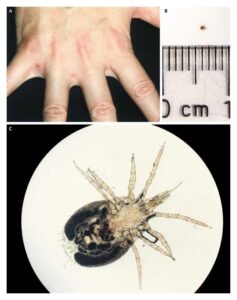This article is an answer to the case – Yellow-Brown Plaque on the Foot
The patient’s lesion is necrobiosis lipoidica (NL), previously known as necrobiosis lipoidica diabeticorum. NL is a rare granulomatous disorder that classically presents as a red-brown plaque with a violaceous, raised border and a yellowbrown atrophic centre with scattered telangiectasias.
The most common areas of involvement are the distal lower extremities, usually in the pretibial region. Lesions of NL can be multiple and are commonly bilateral and symmetric.
NL has been associated with abnormal glucose metabolism. Although the association is not as prevalent as previously thought, up to 11% of patients with NL have diabetes mellitus at the time of presentation and an additional 11% later develop impaired glucose tolerance or diabetes.
The pathogenesis of NL is poorly understood. The primary cause is thought to be due to immune-mediated vascular disease, as collagen degeneration and dermal inflammation are key findings in NL.
Unlike many other cutaneous findings seen in diabetes mellitus, the course of NL does not appear to be affected by the degree of glycemic control and spontaneous resolution is uncommon.
Treatment of Necrobiosis Lipoidica (NL)
NL can be treated with potent topical corticosteroids, with intralesional corticosteroids injected into the active borders of the lesion.
Small case series and anecdotal reports suggest the efficacy of niacinamide and antimalarials and for severe, recalcitrant lesions, tumor necrosis factor-alpha (TNF-α) inhibitors have been used with some success.

